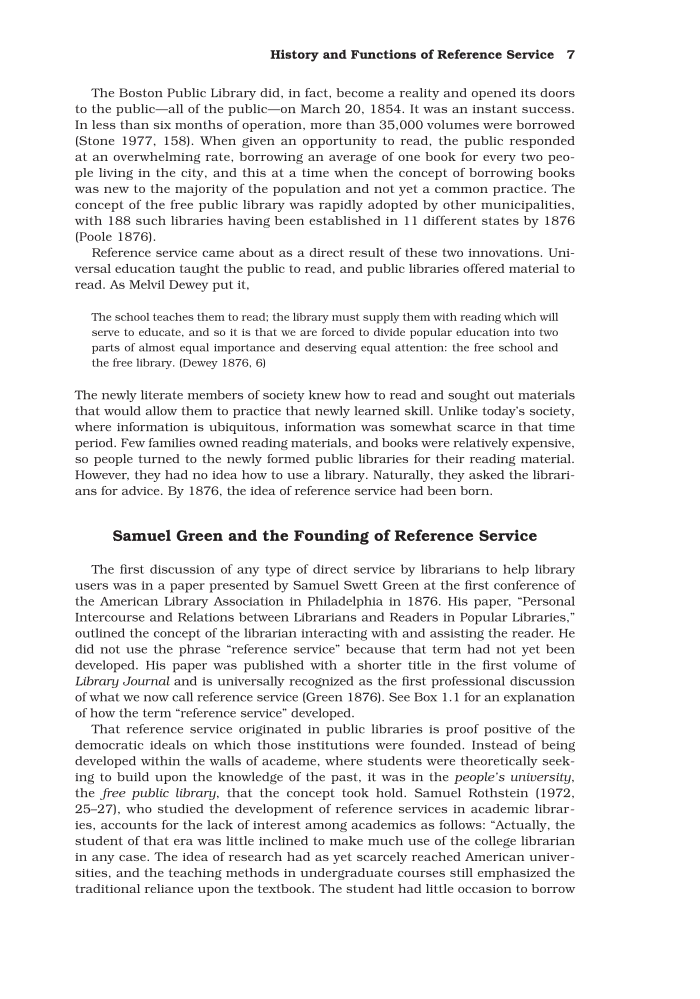History and Functions of Reference Service 7 The Boston Public Library did, in fact, become a reality and opened its doors to the public—all of the public—on March 20, 1854. It was an instant success. In less than six months of operation, more than 35,000 volumes were borrowed (Stone 1977, 158). When given an opportunity to read, the public responded at an overwhelming rate, borrowing an average of one book for every two peo- ple living in the city, and this at a time when the concept of borrowing books was new to the majority of the population and not yet a common practice. The concept of the free public library was rapidly adopted by other municipalities, with 188 such libraries having been established in 11 different states by 1876 (Poole 1876). Reference service came about as a direct result of these two innovations. Uni- versal education taught the public to read, and public libraries offered material to read. As Melvil Dewey put it, The school teaches them to read the library must supply them with reading which will serve to educate, and so it is that we are forced to divide popular education into two parts of almost equal importance and deserving equal attention: the free school and the free library. (Dewey 1876, 6) The newly literate members of society knew how to read and sought out materials that would allow them to practice that newly learned skill. Unlike today’s society, where information is ubiquitous, information was somewhat scarce in that time period. Few families owned reading materials, and books were relatively expensive, so people turned to the newly formed public libraries for their reading material. However, they had no idea how to use a library. Naturally, they asked the librari- ans for advice. By 1876, the idea of reference service had been born. Samuel Green and the Founding of Reference Service The first discussion of any type of direct service by librarians to help library users was in a paper presented by Samuel Swett Green at the first conference of the American Library Association in Philadelphia in 1876. His paper, “Personal Intercourse and Relations between Librarians and Readers in Popular Libraries,” outlined the concept of the librarian interacting with and assisting the reader. He did not use the phrase “reference service” because that term had not yet been developed. His paper was published with a shorter title in the first volume of Library Journal and is universally recognized as the first professional discussion of what we now call reference service (Green 1876). See Box 1.1 for an explanation of how the term “reference service” developed. That reference service originated in public libraries is proof positive of the democratic ideals on which those institutions were founded. Instead of being developed within the walls of academe, where students were theoretically seek- ing to build upon the knowledge of the past, it was in the people’s university, the free public library, that the concept took hold. Samuel Rothstein (1972, 25–27), who studied the development of reference services in academic librar- ies, accounts for the lack of interest among academics as follows: “Actually, the student of that era was little inclined to make much use of the college librarian in any case. The idea of research had as yet scarcely reached American univer- sities, and the teaching methods in undergraduate courses still emphasized the traditional reliance upon the textbook. The student had little occasion to borrow
Document Details My Account Print multiple pages
Print
You have printed 0 times in the last 24 hours.
Your print count will reset on at .
You may print 0 more time(s) before then.
You may print a maximum of 0 pages at a time.





























































































































































































































































































































































































































































































































































































































































































































































































